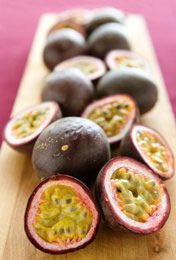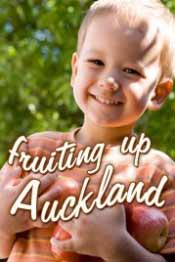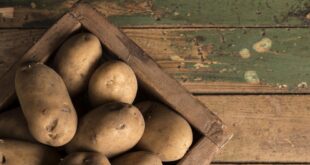Cicadas hum alongside the buzz of our summer garden activities – lawnmowers, children squealing under the spray of the sprinkler, and keen gardeners nurturing their plants through the dry blaze of the summer sun in the months to come.
For lovers of fruit trees, there are two key questions: What should you plant in order to harvest fruit from your garden in future summers? And, if you plant now, how should you plant fruit trees so that they best thrive – and survive – during a hot summer?
What fruits over summer?
 Taking a wander around gardens in early December and you’ll see a lot of anticipation, with buds and fruitlets on pip and stone fruit, passionfruit, grapes and feijoas. Almost the only fruits flourishing are the blueberries and strawberries – and quickly getting eaten by birds! Nature’s way of saying “stay focused on the vegetables”?
Taking a wander around gardens in early December and you’ll see a lot of anticipation, with buds and fruitlets on pip and stone fruit, passionfruit, grapes and feijoas. Almost the only fruits flourishing are the blueberries and strawberries – and quickly getting eaten by birds! Nature’s way of saying “stay focused on the vegetables”?
If your aim is to have a fruity edible garden over summer, here’s some fruit that will be ripe at some time over the Auckland summer (Dec-Mar): Apples, apricots, blueberries, cocktail kiwis, grapefruit, grapes, lemons, mandarins, nectarines, oranges, plums, peaches and pears. Different varieties of a fruit will fruit at different times (eg mandarins) so check the label for summer fruiting varieties.
With your gardening fingers ready for action, now’s the time to ponder which varieties you would like to add to your summer orchard and also what you would like to plant to carry you through the bleakness of winter. Consider too, that some of your preferred varieties may only be available for sale when dormant over winter, so it may be best to research what you’d like, prepare the soil, and plant in winter. Subtropicals, such as passionfruit and tamarillos, are best to plant now so that they’re fairly established before they face the severity of the winter cold.
Whatever you plant now is going to require particular care and attention over the hot summer. A fruit tree plonked in the ground with little care and attention over summer may not immediately die, but if unable to develop a strong and healthy root system, it will become vulnerable to pest and disease attack and ultimately be a poor fruiter. Here are some things to consider:
Best location and soil type for planting in summer
In Auckland you’re either basking in fertile volcanic soil or bouncing your spade off hard clay. And the clay which is rock-hard over summer will become solid squelchy wetness over winter, drowning roots and preventing the take-up of nutrients. All fruit trees like free-draining soil (feijoas and pears are really the only fruit trees that will tolerate sitting in a bit of wet). The good news is that with some soil preparation (6 months in advance is ideal for clay soils), mounding up, and drainage if necessary, most soils can become good environments for fruit trees to grow in.
Fruit trees have typically shallow roots, venturing about 0.5-1m deep and up to twice the width of the tree. The roots are often small and fibrous (think citrus) which increases their vulnerability to fluctuations in soil temperature and water quantity. A fruit tree which has had roots damaged by water-logging over winter will struggle to access adequate water and nutrients over the dry summer, causing a long delayed death which leaves many gardeners confused about what actually went wrong, and when.
When choosing a location think about where those roots will grow and how far they’ll grow. Underneath the calm lawn you could end up with a jumbled lattice of roots all competing for nutrients and water! The popularity of dwarf rootstocks also encourages us to plant trees close together. This is fine as long as consideration is given to the fact that dwarf rootstocks, being by nature stunted, require fertile well-drained soil and are less tolerant of clay soils than the more vigorous standard rootstocks.
Fruit trees need at least 6 hours of direct sunlight each day to grow well, so observe your preferred tree location over the course of the day, keeping in mind that winter sun angles are shorter from the east and west. A north-facing, sheltered, sunny spot will always be best.
How to plant fruit trees in summer
Firstly, make the most of what choices you do have. Check which nursery the fruit tree comes from – it makes sense that a North Island nursery is more likely to grow varieties suited to the Auckland environment. For Auckland I would recommend the popular nurseries Waimea Nurseries, Nelson, and Incredible Edibles, Northland. If you have choices of rootstock, consider whether a dwarf or vigorous rootstock is best for you, depending on space, access to fruit and other possibilities, such as espaliering the tree.
The aim of summer planting is to prepare the soil so it’s able to retain moisture well over summer and free-draining when coming up against the downpours of winter – essentially considering the two extremes!
Discover more about your planting spot by digging a hole twice the width of the rootball, filling it with water and observing how quickly it drains. If it takes much longer than an 40-60 mins, plant in a mound, create some drainage system or consider a different location. In clay soil, score the sides of the planting hole to encourage roots to penetrate through, rather than wrapping around themselves and becoming root bound. Sit your tree in a bucket of water for about half an hour before planting.
Add soil conditioners and water-retaining products to the soil dug from your hole and mix together well. Compost alone can be high in pH which can burn young roots. Remember the aim is to provide a nurturing environment along with a bit of acclimatisation; you don’t want the roots to be shocked once they grow out and venture beyond the comforts of their planting hole.
Organic compost will be your main soil conditioner and, for summer planting especially, I’d recommend adding in Saturaid, an organic slow-release granular soil wetter and Magic Mulch, a seaweed and moss soil tonic which holds water as well as releasing natural minerals and trace elements. If your soil has a high clay content, mix in gypsum, a natural mineral which improves the soil’s texture, drainage and aeration.
A soil that is free-draining but still holds adequate moisture is important in creating an environment in which roots can thrive and absorb nutrients. The addition of organic matter increases the ability of the soil to retain moisture and also provides an energy source for the many beneficial micro-organisms in the soil. Stake dwarf varieties and top-heavy fruit trees, such as tamarillos – it may be calm now but it’s better to secure stakes now before the winter winds take you by surprise.
Mulch covers the top of bare soil and serves to protect the tree largely from the effects of temperature variations, drying winds and competing weeds and grass. Mulch does not need to be too thick – after all you do want the rain to get to the roots rather than staying in the mulch! There are a variety of organic mulch options – from the bagged options at your local garden centre to pea straw or grass clippings. Don’t place mulch too close to the trunk as the microorganisms breaking down the mulch will start to eat into the bark as well, causing the potentially-fatal collar rot.
Irrigation for summer planting
Water every second day depending on rainfall. While the soil may look wet and puddling after a short sprinkle with the hose, it will have only penetrated a few centimeters into the soil. Regular inadequate watering will encourage the roots to grow close to the surface, making them particularly vulnerable to temperature variations and being burnt in the heat of dry soil. It’s also best practice to water into the soil rather than on the leaves as they can scorch under a hot sun.
Saturaid can be applied as a top dressing so consider that for fruit trees already planted. Watering spikes can also be useful for newly planted fruit trees. Controlled by an adjustable dripper, the water is directed straight to the roots and is perhaps most helpful for gardeners who like to know exactly how much water they have given their plants and trees.
Personally I think a dripping hose is best. I find it easiest to put a dripping hose under a tree at night and turn it off in the morning. But if you already know that you won’t be able to commit to this, consider installing an irrigation system. Depending on the layout of your garden, this may be relatively simple and by measuring it up and bringing a plan into a hardware store or garden centre, you’ll be able to come away with all the necessary tubing and risers to do the job yourself.
Nurturing to protect against summer pest and disease attack
A strong healthy tree, which has access to water and nutrients is far less vulnerable to pests and diseases. But over summer all fruit trees will have some bugs on them – think of it as a buffet for all the beneficial insects in your garden!
Using organic products is the best way to preserve soil life, beneficial insects in the garden and, using sprays without withholding periods, means that your garden is safe for spontaneous buffet browsing! Summer is a good time for feeding with nitrogen-rich fertilizers, such as blood and bone, to encourage all that leafy growth to be well completed before winter as young leaves won’t like the cold. Remember that fruit trees need potassium (K) for flower and fruit development so choose a fertilizer with a high K value, such as sheep pellets, seaweed, comfrey, or sulphate of potash. Water well into soil, keep off the foliage and spray in the evening when bug activity will be least disrupted.
Strong, well-nurtured fruit trees, even when young, are far less susceptible to pest and disease attack as they can use their natural defenses, such as altering their leaves to taste bitter when attacked by a chewing or rasping insect. Spring and early summer are your only times to control pesky bugs before their population blow-out over summer. If bugs such as aphids or mealy bugs are becoming too numerous to remove by hand and you want to take action, consider spraying with Neem Tree Oil (safe for bees and ladybirds) in the evening, with applications a few days apart.
 Summer is also the time to protect against heat, humidity and the consequent fungal infections. Wally’s Vaporgard is an organic anti-transpirant, preventing water loss and protecting against UV damage and wind-burn with each application lasting 3 months. Tui Eco-fungacide is a contact fungacide that changes the pH on the leaf surface disrupting fungal growth, eg powdery mildew and black spot. Sulphur is another organic age-old remedy and is effective on a range of diseases, such as powdery mildew, botrytis, black spot and also acts as a miticide. There is a one day withholding period before eating food crops. You can further reduce fungal problems by pruning only on dry, low-humidity days and creating an airy environment so that fungal spores can be blown away.
Summer is also the time to protect against heat, humidity and the consequent fungal infections. Wally’s Vaporgard is an organic anti-transpirant, preventing water loss and protecting against UV damage and wind-burn with each application lasting 3 months. Tui Eco-fungacide is a contact fungacide that changes the pH on the leaf surface disrupting fungal growth, eg powdery mildew and black spot. Sulphur is another organic age-old remedy and is effective on a range of diseases, such as powdery mildew, botrytis, black spot and also acts as a miticide. There is a one day withholding period before eating food crops. You can further reduce fungal problems by pruning only on dry, low-humidity days and creating an airy environment so that fungal spores can be blown away.
—————————————————————————————————————
Fruity Gumboot specialises in planting and maintaining fruit trees in Auckland. We use organic methods, contribute to the community through charitable plantings, and place emphasis on inspiring interest in the garden, particularly amongst children. Best of all we guarantee our expertise and care – if a fruit tree fails to thrive after the year is up we replace it!
Join up to the Fruity Gumboot Pips ‘n’ Peel newsletter – with giveaways, special offers and always great gardening tips
 Join the Fruity Gumboot Pips ‘n’ Peel Newsletter.
Join the Fruity Gumboot Pips ‘n’ Peel Newsletter.
Click here to visit our website, or phone 09 820 8991 or email info@fruitygumboot.co.nz .
—————————————————————————————————————









- 11 years ago
apple